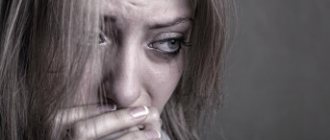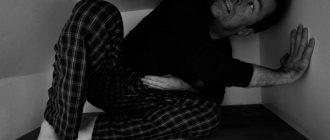Common fear and phobia - is there a difference between them? Yes, and very big. Fear is a state, an emotion, in which a person experiences severe anxiety from a real or imagined threat. At these moments, adrenaline enters the blood - the hormone of fear, which mobilizes the body's hidden reserves and allows one to avoid danger.
Fear is even useful in cases where it protects against reckless actions, thereby preserving life. It would be wrong to ask yourself the question of how to overcome fear in a situation where there is not an imaginary, but a very real threat. But in cases where fear arises without any significant reasons, when it is cyclical and cannot be controlled, then we are talking about a phobia.
Phobias, which picture dangers in a person’s imagination that most often do not exist, have an extremely negative impact on his life, limit freedom, subjugating part of a person’s life.
Once a fear has turned into a phobia, it is almost impossible to overcome it on your own ; it is a mental disorder, and you cannot do without the help of a specialist. Early diagnosis of phobias largely determines the effectiveness of therapy and how soon they will stop preventing you from living your life to the fullest. Don't put off visiting your doctor!
How to overcome fear - recommendations from psychologists at our clinic
It is worth noting that when various kinds of fears arise that are episodic in nature and do not “enslave” a person’s will, it is possible to try to cope with them on your own. Knowing how to overcome fear, it is quite possible to overcome it.
- Get together and do it. No matter how difficult life situations are, act without paying attention to the approaching fear. Anything you haven't done before or anything new can create uncertainty and fear. How you feel fear, weak or strong, is influenced by the strength of belief, which must be changed by action. Only by doing something will you drive away fear, but procrastination increases it. Accept that you are scared, accept the fear, but do it as you intended. Remember, long thoughts will not answer how to overcome fear; you just have to act! Believe in luck.
- What could be worse when it couldn't be worse? When you need to do something, but it’s scary, imagine the most negative turn of possible events. Believe me, this is much better than the unknown, which is called “the most devastating weapon of fear.” Only by understanding and finding the source of fear can you see that it is not scary. But fear is also a defensive reaction. Therefore, if, after calculating all the consequences of the most undesirable option in which events will develop, fear remains, then it is worth thinking about the need for these actions. Assess your own fear - if it is not groundless, then hear it by making the right decision.
- The decision has been made - carry it out. Get serious about doing something, giving yourself the determination not to deviate from what you have planned - there will be no fear, it will go away. Fear feeds on our doubts and insecurities. He “whispers” to the mind that everything will be bad, negative. When considering your actions and making a decision, always hope for a good ending. Do not allow negative thoughts, drive them away. Remember? The eyes are scared, but the hands continue to act. Without a doubt, make a decision by telling yourself that there is no turning back. Be decisive, and the task of how to overcome fear will no longer be unanswerable.
- Analysis of fear. Don’t ask the question of how to overcome fear, but analyze it. Fear refers to emotions that are stronger than logic. Even understanding the meaninglessness of fear, you can continue to be afraid. “Scroll” the entire course of events in your mind, overcome this feeling in your imagination, this technique will help you cope with it in reality - the model of events is fixed on the subconscious level. A technique based on self-hypnosis - visualization - is very effective.
- We train courage. Identify your own “core” fear. Then break it down into smaller fears that you can begin to overcome. Does not work? Again, break down any fear you have into small ones. Then, step by step, overcome them. Heroes know how to overcome fear. Be brave and you can become that hero.
- Increasing your own self-esteem is a good answer to the question of how to overcome fear. Think only well of yourself, even if your own self-esteem is overestimated. It has been noticed that people with high self-esteem, although somewhat biased, achieve more than those who evaluate themselves adequately.
- Belief in a higher power and a guarding angel. Fear goes away if you have faith that someone, very strong, cares and protects you.
- Feeling of love. There is no fear that love cannot overcome.
- Always smile. Only positive emotions can overcome fear, and negative ones make it stronger.
Knowing how to overcome fear will give you the strength to cope with it. But remember that a phobia requires the mandatory help of a psychotherapist. She is cunning and not to be trifled with.
Cognitive behavioral therapy
One of the most effective methods of combating phobias, which is gaining increasing popularity in Russia, is cognitive behavioral therapy. Cognitive techniques help to recognize and analyze the mechanisms of occurrence of phobias, and subsequently change/correct a person’s negative perception of events or situations.
Cognitive behavioral therapy is a joint work of a patient and a psychologist, during which a person acquires the skills of independent control of his thinking, emotions, behavior, and physiology. By monitoring one's emotional state and trying to change negative thinking, a person has the opportunity to resist attacks of uncontrollable fear and overcome the fatality of panic that accompanies this fear.
Making an appointment with a specialist is your first bold step in the fight against a phobia.
We are ready to help you! Call us
Get rid of fear, anxiety or phobia forever. Is it possible to?
FearAnxietyPhobia
Today we will talk about another large group of psychological problems that require the help of a professional psychologist or psychotherapist - namely, fears and phobias, as well as anxiety . I will tell you what it is, why it occurs, what therapy is possible and what the prognosis is.
What are fear and anxiety?
Firstly, fears and phobias are not the same thing. Fear - in terms of physiological processes in the body, it is similar to anxiety: it is the response of the central nervous system to threat and danger. This response of the nervous system is presented both in the form of body reactions (sweating, increased heart rate, muscle tension, nausea, trembling, etc.) and in the form of emotions (actually fear, anxiety, horror, panic, disgust, etc. .), as well as in the form of certain thoughts (“we must run”).
A very specific object for the appearance of fear: a dog
Fear is caused by a certain , very specific object or situation that is threatening or dangerous. And if there is no object, but fear is present - that is, a feeling something like “it’s unclear what bad thing will happen” - this is anxiety, or a state of an uncertain threat or danger. Everyone has different levels of personal anxiety - some are more relaxed, others are more tense all the time. I have already written about the difference between anxiety and anxiety.
When the brain evaluates something as threatening, it stimulates the autonomic nervous system, which also causes the heart to beat faster, the adrenal glands to release corticosteroid hormones into the blood, etc., which is felt as anxiety or fear. When the threat has passed, the brain once again activates the autonomic nervous system so that it restores normal order in the body.
But sometimes, for certain reasons, the brain incorrectly perceives a threat or danger, namely, it perceives it when it actually does not exist . But the brain still keeps the autonomic system active, and the person still experiences severe anxiety. And so all the time. This is how anxiety disorder .
People usually describe their condition like this: “I can’t do anything. I worry about everything all the time. I'm constantly worried that something will happen. I find it difficult to concentrate, and everything falls out of my hands. Even at work, I constantly worry that this condition will cause me to make mistakes and get fired. Because of this, I can’t concentrate on what I’m doing at all.”
In psychodynamic psychotherapy (psychoanalysis, etc.), it is assumed that anxiety disorder occurs when the defense mechanisms of the psyche cannot withstand stress and are overwhelmed by neurotic and moral anxiety, as well as when the existing defense mechanisms are weak to adequately withstand stress. We all come from childhood, so psychotherapists who support the psychodynamic model will look for the causes of an anxiety disorder somewhere in your childhood, for example, in the child-parent relationship, in overprotection, in punishment or excessive patronage of parents, etc.
Cognitive behavioral therapy is based on the premise that anxiety disorders are triggered by dysfunctional, maladaptive assumptions or beliefs, such as “It is imperative that everyone respects me” or “It is terrible when things don’t go the way we would like.” When a person encounters in life a large number of facts and situations that contradict his basic irrational attitudes, and the influence of these attitudes extends to more and more areas of his life, an anxiety disorder may develop.
A cognitive behavioral therapist will focus on working on maladaptive beliefs and learning to cope with stress.
For example, a psychologist will teach you how to keep a diary of thoughts, feelings, and behavior, and can teach you a technique called “Stress Vaccination,” which helps increase self-confidence in dealing with stress. In addition, some time will be devoted to learning to cope with situations of uncertainty that make clients with anxiety disorders very fearful. Due to the fact that uncertainty is disturbing, the predictability of the outcome decreases, which, in turn, as a vicious circle, causes an increase in anxiety.
In addition to psychotherapeutic methods, your doctor may prescribe anti-anxiety medications.
Specific phobias: fear of heights, darkness, closed spaces (claustrophobia), fear of flying (aerophobia), etc.
But if the brain “chose and now prefers” a certain object as a threat and danger, for example, flying on an airplane, or spiders, or darkness, then a person may develop a specific phobia .
Fear of people and social situations, public speaking is called social phobia , fear of appearing in public places is called agoraphobia . There will be a separate story about them, because these two types of phobias are a little separate.
This, of course, is normal if you are afraid of something, for example, the dark or flying on an airplane. How do you know if you have a phobia or a natural fear of a dangerous object? A phobia is a strong and persistent experience and causes such stress that it affects personal, social or professional life. A person begins to avoid situations in which he may encounter a feared object. But some objects are difficult to avoid, so if you encounter them, a person experiences severe fear or panic. By the way, there are also panic disorders , which are often accompanied by agoraphobia - there will also be a separate discussion about them.
So, if because of your fears your personal, professional or social life is in any way disrupted, changed, if you understand that your fears are excessive, then it is a phobia. If, by and large, you just like to talk with someone on the topic “oh, how afraid I am of spiders, I probably have real arachnophobia, this is some kind of horror!”, and at the same time this does not affect your life in any sense affects - it's not a phobia.
Most people never turn to a psychologist for advice about their fears - because it seems easier to them to avoid frightening objects. Sometimes phobias go away on their own (especially if they started in childhood). But if the phobia began in adulthood, it will most likely persist and decrease only as a result of psychotherapeutic or drug treatment.
However, sometimes life turns out in such a way that you cannot avoid the object of your phobia. For example, you have aerophobia (fear of flying), and you need to pursue a career where you can’t do without regular business trips. What then? Then the choice remains: either quit your career or engage in aerophobia.
The second is more beneficial because cognitive behavioral therapy for specific phobias shows relatively rapid success rates of up to 95% of cases. At the moment, the most widely used and highly effective method for combating phobias is the exposure method .
What are the types of phobias?
- poverty
- pregnancy
- wind
- water
- air
- heights
- homosexuality
- robbers
- thunderstorms
- rain
- animals
- mirrors
- snake
- walk across the bridge
- needles
- skin diseases
- blood
- dolls
- horses
- mechanisms
- furs
- microbes
- graves
- mice
- meat
- nights
- fire
- spiders
- flights
- ghosts
- birds
- empty premises
- wounds and injuries
- speed
- snow
- dogs
- darkness
- crowds
- injections
- churches
- worms
- noise
- poison
- and anything else
Exposure treatment for phobias
There are many varieties of this method, but at the moment it is the most effective and most effective for the treatment of specific phobias. Of course, provided that it is carried out by a professional psychotherapist and the client has the motivation to get rid of the phobia.
The essence of the method comes down to the fact that the client is “exposed” to the influence of the object that he is afraid of, but exposed in a special way, under careful control and discussion of what is happening:
- gradually, from the least terrible to the most terrible;
- constantly monitoring the client’s condition and discussing with him what is happening, what he feels, etc.;
- the client’s conscious refusal to avoid avoidance tendencies, avoid fears and discuss them, the desire to overcome fear;
- the psychotherapist also participates in the procedure as a model;
- in parallel, cognitive-behavioral influence is carried out on dysfunctional beliefs and training (coaching) of the client in methods of normal handling of the object of fear;
- the effect continues until the level of fear and anxiety reaches a maximum, after which it levels off for a while, and then immediately drops dramatically. At the next stage, the level of fear no longer reaches such a height. The point is that you need to consciously, under control, knowing ways to help, “endure” this impact several times - and most importantly, do not quit in the middle, because this “feeds” the phobia! - after which almost everyone experiences significant relief from the symptoms of the phobia.
According to research by the author of the OST (one-session treatment for specific phobias) method, Swedish psychiatrist L.G. Ost and his followers, such an approach to the treatment of specific phobias leads to a drop in the level of fear and anxiety in one three-hour session to at least 50%, and usually almost to zero. In the future, the client needs several supporting sessions, and, of course, the most important thing is the practice of the client himself in real life.
Other treatments for specific phobias
In addition to the exposure method and its variations, other methods are currently used to treat phobias, such as desensitization, flooding and modeling.
In all of these methods, as well as in exposure, the client will confront the object of their fear (because this is the most effective way to get rid of it). In the first case, with desensitization, the client is taught to relax simultaneously with the appearance of situations or objects that frighten them. Since simultaneous relaxation and fear are physiologically incompatible, it is believed that the fear response will be reduced.
During a flood, the presentation of frightening objects or situations does not occur gradually, and also without relaxation exercises. The client is taught to cope with fear immediately, without any special training.
In the case of using the modeling method, the therapist acts as a “guinea pig”, and the client observes the actions, reactions and state of the therapist from the outside. Subsequently, the client joins the therapist. Modeling is also partially used in the exposure method, as one of the components.
Summarizing all approaches to professional psychological assistance for anxiety or phobias, we can say that the most effective method of assistance is a controlled encounter between a person and the object of fear.
Provided by SendPulse











